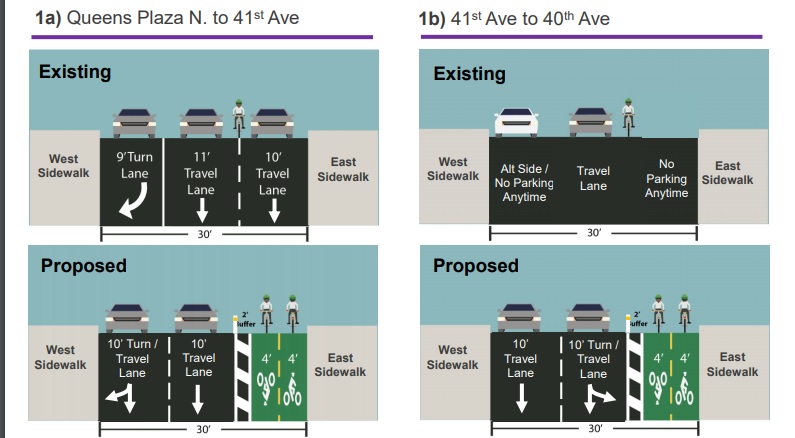
Crescent Street and Queens Plaza North (Google)
June 17, 2020 By Christian Murray
Community Board 1 unanimously approved the Department of Transportation’s plan for a protected bicycle lane on a stretch of Crescent Street at last night’s monthly board meeting held on Zoom.
The DOT presented plans to install a protected bicycle lane on Crescent Street between the Queensboro Bridge and RFK Bridge. Construction of the two-way protected bicycle lane is expected to begin later this year and the lane would go up on the east side of the street, according to the DOT.
Many safe-street advocates have been calling for a protected bicycle lane on this portion of Crescent Street for years, since it would provide a safe passage between the two bridges. Many cyclists use Crescent Street to get to the Queensboro Bridge as means to get into Manhattan, while the RFK Bridge is a connection to Randalls Island and the Bronx.
The DOT said that Crescent Street has been designated as a Vision Zero priority area. The agency said that nine people were killed or seriously injured between Jan. 1, 2013 and April 29, 2020 on Crescent street between Queens Plaza North and Hoyt Avenue North.

Crescent Street design changes between Queens Plaza North and 40th Avenue (DOT)
“A north-south connection is going to provide a reliable, safe transportation option for the folks in Queens and particularly in your community,” Nicole Garcia, the Queens Commission of the DOT, said during last night’s presentation. “The reason we are proposing this is to make it safer for cyclists… and where we put down these protected bike lanes it tends to be safer for all street users—especially pedestrians.”
The protected bicycle lane, which would see the loss of about 5 to 10 parking spots per block, has received community support and comes at a time when bicycling is on the rise.
Council Members Costa Constantinides and Jimmy Van Bramer support the Crescent Street plan and CB1’s Transportation Committee unanimously backed it. Letters submitted to the community board by the public also were largely in favor. In addition, during a February DOT workshop—most of the 130 attendees advocated for it.
The lane is part of a bicycle infrastructure network the DOT is trying to implement in the Astoria area.

Existing and Proposed Bike Network (DOT)
The DOT said it has plans to install a number of other bicycle lanes this year as part of the network, which involve conventional and share bike lanes.
The routes feature a north-south connection that goes from 20th Avenue to 34th Avenue incorporating 42nd, 43rd and 44th Streets as well as a connection between 20th Avenue and Hoyt Avenue North on Crescent Street and 24th Street.
The agency also has plans to construct a protected bicycle lane on 31st Street—under the N/W elevated line—from 20th Avenue to 39th Avenue. However, priority has been given to Crescent Street, which can be implemented much faster and involves fewer resources.
Crescent St Redesign as presented to CB1 June2020 by Queens Post on Scribd
